
The Serious Freshening
Go to <Last, Summary, Next>Exterior—Paint Color History of Bugsby
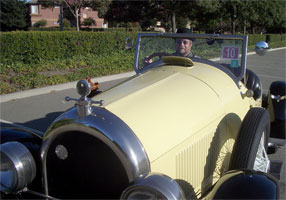 Lynn in Bugsby, September 5, 2005 |
Revised: 2006-04-09 — Started: 2006-02-09
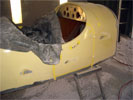 |
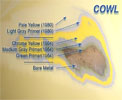 |
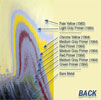 |
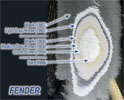 |
| DETAILED FORENSICS: Using a sander, Lynn creates a series of feathered holes in the paint of all the body panels (left). Lynn's revised reading of the paint history of Bugsby is show for the cowl (left center), rear turtle back (right center) and one of the fenders (right). |
Work Completed:
During the initial stages of stripping the paint off Bugsby,
Lynn realizes that he should make a more detailed investigation into the color history of the car before
all the evidence is lost.
Lynn asks Kevin Schell's permission to do additional forensics on the layers of paint.
Kevin lends Lynn an 8" dual action sander with 160 grit sandpaper so that he can create feathered diagnostic holes
in the paint. Based on a careful examination of these slices through the finish, Lynn feels that he has a good handle on the color history of the paint that was on the car.
Bill Trollope, the previous owner, told Lynn that Bill bought the car in 1976 and performed a number of restorations to the car, including new paint. So the outer layer of paint was applied in Sydney, Australia, sometime after 1976 and before about 1980.
There appear to be only two color coats on the car and Lynn formerly thought that the earlier color was the finish with which the car left the factory in 1924. However, John Lewis has corrected that misimpression as the earlier paint was apparently applied by Ron Griffiths in about 1964 during his restoration of the car. Ron told John that he matched his paint to the original color of the car, but it is currently an open question in Lynn's mind exactly how closely that match was made. Ron also said that the car originally had black fenders and a green leather interior.
The green-yellow layer closest to the metal is most likely a zinc chromate primer. Zinc chromate primers are typically used to coat bare metal (often after a wash with phosphoric acid) and provide some corrosion resistance.
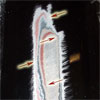 |
| VANISHING LAYERS: Lynn feels that these vanishing layers indicate that alternate layers of contrasting primer were used in the finishing process. |
Lynn also feels that he understands the red color layers on the turtle back and rear portion of the car. This appears to be a technique of using alternating contrasting primer layers to aid in the finishing process. Lynn learned of this technique while perfecting his finishes for his earlier hobby of model and high-power rocketry. Using primer layers of contrasting colors, it is easier visually to see uneven spots in the finish. Lynn observes on Bugsby that some of the red or gray primer layers simply vanish as he follows them around his diagnostic slices. This behavior would be consistent with sanding through one of the layers during the finishing process.
Work Remaining:
None.
Contact
 with your comments or questions
with your comments or questionsCopyright © 2018 Lynn Kissel
Last updated: May 24, 2009